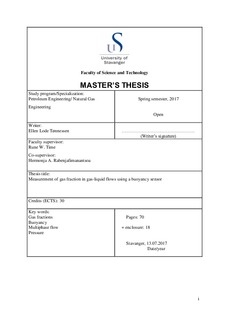| dc.contributor.advisor | Time, Rune Wiggo | |
| dc.contributor.author | Tønnessen, Ellen Lode | |
| dc.date.accessioned | 2017-10-26T08:30:59Z | |
| dc.date.available | 2017-10-26T08:30:59Z | |
| dc.date.issued | 2017-07-13 | |
| dc.identifier.uri | http://hdl.handle.net/11250/2462279 | |
| dc.description | Master's thesis in Petroleum engineering | nb_NO |
| dc.description.abstract | In this thesis, an innovative new method for measuring in-situ gas fraction in vertical flowing pipes is proposed as an alternative to using differential pressure. The new method has been tested by developing an experimental test setup, and running experiments at the University of Stavanger’s Multiphase Laboratory. Key elements in the setup is a stationary pendulum immersed into a pipe filled with water and gas, and connected to a force sensor. By measuring the apparent weight of the pendulum, theory of buoyancy is used to calculate the gas fraction in the pipe. The gas fraction inside the pipe are controlled by using a flow meter to inject gas from the bottom of the pipe. The in-situ gas fraction calculated with the new method are verified by comparing it with readings of the liquid level of fluid inside the pipe and by using a differential pressure gauge simultaneously in the experimental setup.
In order to find an adequate experimental setup, a lot of trial and error in the experimental setup were necessary. During the trial and error period the design and density of the pendulum, the accuracy of the force sensor, the viscosity of the fluid, and type of gas injector were noticed to be of great importance to prevent movement of the pendulum and to get reliable results.
The results from the experiments showed a clear connection between the apparent weight of the pendulum measured by the force sensor and the expected buoyancy of the pendulum for different gas fractions. A comparison with the results from the use of the already existing differential pressure method showed that as the differential pressure, the apparent weight of the pendulum is also affected by pressure gradients. Including to depending on the pressure in the fluid, the apparent weight of the pendulum, was also found to be dependent on a linear force which is most likely caused by viscus forces.
These experimental results are promising. However, further research and development are needed before the new method can be tested out on in an industrial setting. | nb_NO |
| dc.language.iso | eng | nb_NO |
| dc.publisher | University of Stavanger, Norway | nb_NO |
| dc.relation.ispartofseries | Masteroppgave/UIS-TN-IPT/2017; | |
| dc.rights | Navngivelse 4.0 Internasjonal | * |
| dc.rights.uri | http://creativecommons.org/licenses/by/4.0/deed.no | * |
| dc.subject | petroleumsteknologi | nb_NO |
| dc.subject | two-phase flow | nb_NO |
| dc.subject | petroleum engineering | nb_NO |
| dc.subject | naturgass | nb_NO |
| dc.subject | natural gas engineering | nb_NO |
| dc.title | Measurement of gas fraction in gas-liquid flow using a buoyancy sensor | nb_NO |
| dc.type | Master thesis | nb_NO |
| dc.description.version | submittedVersion | nb_NO |
| dc.subject.nsi | VDP::Teknologi: 500::Berg‑ og petroleumsfag: 510::Petroleumsteknologi: 512 | nb_NO |

